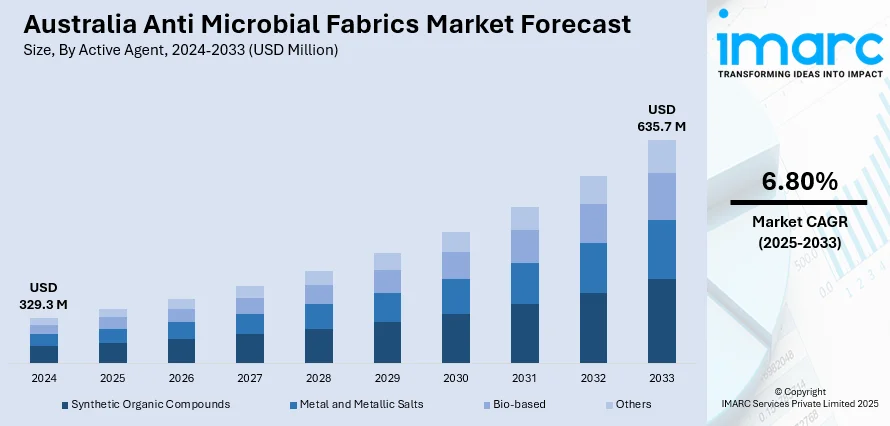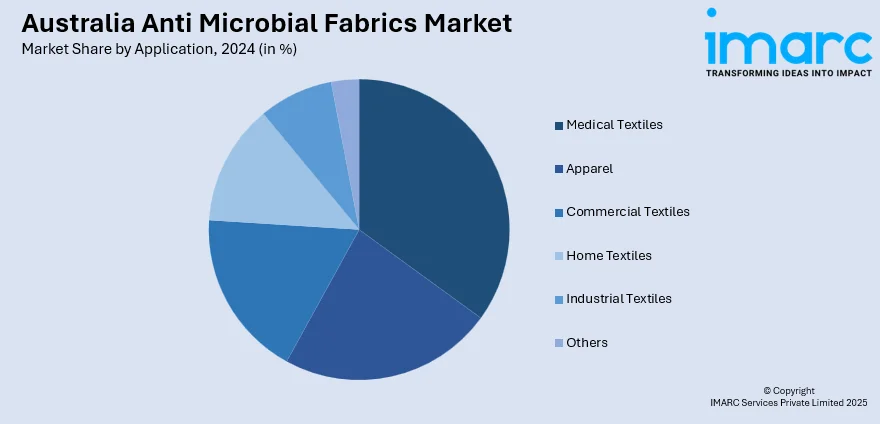
Australia Anti Microbial Fabrics Market Size, Share, Trends and Forecast by Active Agent, Application, and Region, 2025-2033
Australia Anti Microbial Fabrics Market Overview:
The Australia anti microbial fabrics market size reached USD 329.3 Million in 2024. Looking forward, IMARC Group expects the market to reach USD 635.7 Million by 2033, exhibiting a growth rate (CAGR) of 6.80% during 2025-2033. At present, the growing health awareness among the masses is driving the demand for products that offer added protection against germs and bacteria. In addition, hotel guests prefer accommodations that promote health and safety, motivating hospitality providers to wager on advanced anti microbial materials. Besides this, the broadening of aged care facilities is contributing to the expansion of the Australia anti microbial fabrics market share.
|
Report Attribute
|
Key Statistics
|
|---|---|
|
Base Year
|
2024
|
|
Forecast Years
|
2025-2033
|
|
Historical Years
|
2019-2024
|
|
Market Size in 2024
|
USD 329.3 Million |
|
Market Forecast in 2033
|
USD 635.7 Million |
| Market Growth Rate 2025-2033 | 6.80% |
Australia Anti Microbial Fabrics Market Trends:
Increasing health awareness
The growing health awareness among people is positively influencing the market. As people are becoming conscious about hygiene and disease prevention, they are seeking fabrics that help reduce the risk of infections in daily life. As per industry reports, in 2024, over 80 cases of meningococcal infections were documented throughout Australia. People prefer clothing, home textiles, and accessories that include anti microbial properties, especially in public and high-contact environments. This trend is growing stronger in settings like healthcare, where anti microbial fabrics are used for uniforms, bedsheets, and curtains to maintain cleanliness and safety. The same demand is extending to fitness wear, where odor and bacteria control are important. Schools, offices, and public spaces are also adopting anti microbial materials in their furnishings. With health being a priority, brands are responding by offering items that combine comfort, durability, and germ protection. The increased use of anti microbial fabrics in everyday life reflects a broader shift in user behavior towards wellness and prevention.

To get more information on this market, Request Sample
Growing applications in hospitality sector
The rising applications of anti microbial fabrics in the hospitality sector are positively influencing the market. Hotels, resorts, and short-stay accommodations focus on hygiene to meet customer expectations and industry standards. Anti microbial fabrics help reduce the spread of germs on items like bedding, towels, curtains, and upholstery, which are used frequently by different guests. With increasing number of tourists, higher occupancy rates, and faster room turnovers, these fabrics offer added protection without constant deep cleaning. As per the information provided on the official website of the Australian Bureau of Statistics, in March 2025, the total number of tourists reached 1,688,650, showcasing a rise of 4.6% compared to 2024. Guests prefer accommodations that promote health and safety, motivating hospitality providers to invest in advanced materials. The use of anti microbial fabrics also improves the overall brand image and builds customer trust. As hygiene is becoming a key part of the guest experience, the hospitality sector continues to drive the demand for high-quality anti microbial textile solutions in Australia.
Expansion of aged care facilities
The expansion of aged care facilities is impelling the Australia anti microbial fabrics market growth. The country is experiencing a steady rise in its aging population, which is leading to greater investments in residential and healthcare services for older adults. The 2024 Population Statement indicated that Australia had over 2.1 Million individuals aged 75 and older. This figure is set to exceed 3.2 Million by 2034. Aged care environments require strict infection control, and anti microbial fabrics help reduce the spread of bacteria, viruses, and fungi. These fabrics are used in bedding, curtains, furniture covers, and staff uniforms to maintain a clean and healthy setting. Older individuals often have weaker immune systems, so facilities aim to create safer surroundings through anti microbial materials. The fabrics also reduce odors and require less frequent washing, which improves operational efficiency. As aged care centers are expanding to meet rising needs, they are adopting modern materials that combine comfort, safety, and hygiene.
Australia Anti Microbial Fabrics Market Segmentation:
IMARC Group provides an analysis of the key trends in each segment of the market, along with forecasts at the country and regional levels for 2025-2033. Our report has categorized the market based on active agent and application.
Active Agent Insights:
- Synthetic Organic Compounds
- Metal and Metallic Salts
- Bio-based
- Others
The report has provided a detailed breakup and analysis of the market based on the active agent. This includes synthetic organic compounds, metal and metallic salts, bio-based, and others.
Application Insights:

- Medical Textiles
- Apparel
- Commercial Textiles
- Home Textiles
- Industrial Textiles
- Others
A detailed breakup and analysis of the market based on the application have also been provided in the report. This includes medical textiles, apparel, commercial textiles, home textiles, industrial textiles, and others.
Regional Insights:
- Australia Capital Territory & New South Wales
- Victoria & Tasmania
- Queensland
- Northern Territory & Southern Australia
- Western Australia
The report has also provided a comprehensive analysis of all the major regional markets, which include Australia Capital Territory & New South Wales, Victoria & Tasmania, Queensland, Northern Territory & Southern Australia, and Western Australia.
Competitive Landscape:
The market research report has also provided a comprehensive analysis of the competitive landscape. Competitive analysis such as market structure, key player positioning, top winning strategies, competitive dashboard, and company evaluation quadrant has been covered in the report. Also, detailed profiles of all major companies have been provided.
Australia Anti Microbial Fabrics Market Report Coverage:
| Report Features | Details |
|---|---|
| Base Year of the Analysis | 2024 |
| Historical Period | 2019-2024 |
| Forecast Period | 2025-2033 |
| Units | Million USD |
| Scope of the Report |
Exploration of Historical Trends and Market Outlook, Industry Catalysts and Challenges, Segment-Wise Historical and Future Market Assessment:
|
| Active Agents Covered | Synthetic Organic Compounds, Metal and Metallic Salts, Bio-based, Others |
| Applications Covered | Medical Textiles, Apparel, Commercial Textiles, Home Textiles, Industrial Textiles, Others |
| Regions Covered | Australia Capital Territory & New South Wales, Victoria & Tasmania, Queensland, Northern Territory & Southern Australia, Western Australia |
| Customization Scope | 10% Free Customization |
| Post-Sale Analyst Support | 10-12 Weeks |
| Delivery Format | PDF and Excel through Email (We can also provide the editable version of the report in PPT/Word format on special request) |
Key Questions Answered in This Report:
- How has the Australia anti microbial fabrics market performed so far and how will it perform in the coming years?
- What is the breakup of the Australia anti microbial fabrics market on the basis of active agent?
- What is the breakup of the Australia anti microbial fabrics market on the basis of application?
- What is the breakup of the Australia anti microbial fabrics market on the basis of region?
- What are the various stages in the value chain of the Australia anti microbial fabrics market?
- What are the key driving factors and challenges in the Australia anti microbial fabrics market?
- What is the structure of the Australia anti microbial fabrics market and who are the key players?
- What is the degree of competition in the Australia anti microbial fabrics market?
Key Benefits for Stakeholders:
- IMARC’s industry report offers a comprehensive quantitative analysis of various market segments, historical and current market trends, market forecasts, and dynamics of the Australia anti microbial fabrics market from 2019-2033.
- The research report provides the latest information on the market drivers, challenges, and opportunities in the Australia anti microbial fabrics market.
- Porter's five forces analysis assist stakeholders in assessing the impact of new entrants, competitive rivalry, supplier power, buyer power, and the threat of substitution. It helps stakeholders to analyze the level of competition within the Australia anti microbial fabrics industry and its attractiveness.
- Competitive landscape allows stakeholders to understand their competitive environment and provides an insight into the current positions of key players in the market.
Need more help?
- Speak to our experienced analysts for insights on the current market scenarios.
- Include additional segments and countries to customize the report as per your requirement.
- Gain an unparalleled competitive advantage in your domain by understanding how to utilize the report and positively impacting your operations and revenue.
- For further assistance, please connect with our analysts.
 Request Customization
Request Customization
 Speak to an Analyst
Speak to an Analyst
 Request Brochure
Request Brochure
 Inquire Before Buying
Inquire Before Buying




.webp)




.webp)












